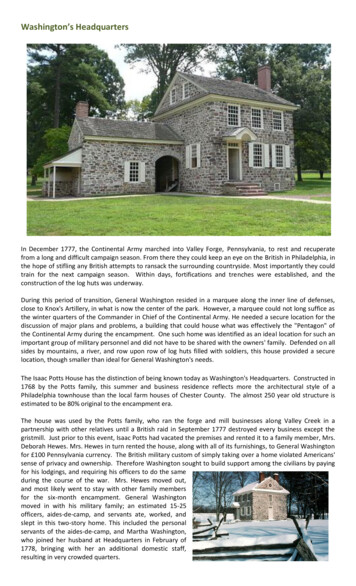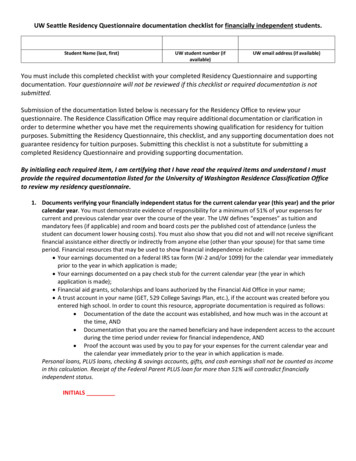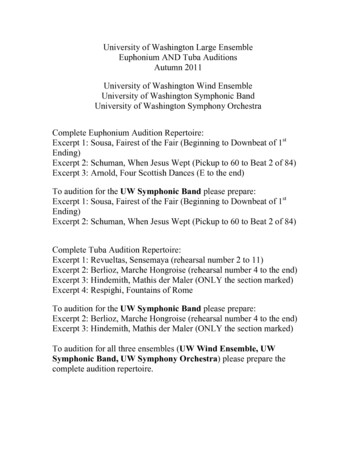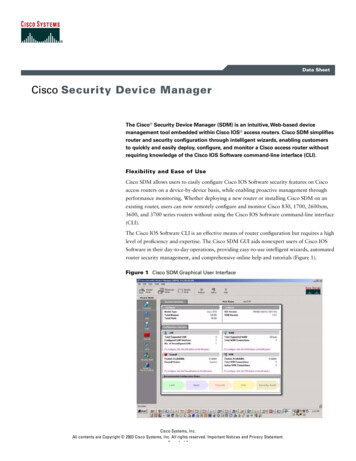
Transcription
Washington’s HeadquartersIn December 1777, the Continental Army marched into Valley Forge, Pennsylvania, to rest and recuperatefrom a long and difficult campaign season. From there they could keep an eye on the British in Philadelphia, inthe hope of stifling any British attempts to ransack the surrounding countryside. Most importantly they couldtrain for the next campaign season. Within days, fortifications and trenches were established, and theconstruction of the log huts was underway.During this period of transition, General Washington resided in a marquee along the inner line of defenses,close to Knox's Artillery, in what is now the center of the park. However, a marquee could not long suffice asthe winter quarters of the Commander in Chief of the Continental Army. He needed a secure location for thediscussion of major plans and problems, a building that could house what was effectively the "Pentagon" ofthe Continental Army during the encampment. One such home was identified as an ideal location for such animportant group of military personnel and did not have to be shared with the owners' family. Defended on allsides by mountains, a river, and row upon row of log huts filled with soldiers, this house provided a securelocation, though smaller than ideal for General Washington's needs.The Isaac Potts House has the distinction of being known today as Washington's Headquarters. Constructed in1768 by the Potts family, this summer and business residence reflects more the architectural style of aPhiladelphia townhouse than the local farm houses of Chester County. The almost 250 year old structure isestimated to be 80% original to the encampment era.The house was used by the Potts family, who ran the forge and mill businesses along Valley Creek in apartnership with other relatives until a British raid in September 1777 destroyed every business except thegristmill. Just prior to this event, Isaac Potts had vacated the premises and rented it to a family member, Mrs.Deborah Hewes. Mrs. Hewes in turn rented the house, along with all of its furnishings, to General Washingtonfor 100 Pennsylvania currency. The British military custom of simply taking over a home violated Americans'sense of privacy and ownership. Therefore Washington sought to build support among the civilians by payingfor his lodgings, and requiring his officers to do the sameduring the course of the war. Mrs. Hewes moved out,and most likely went to stay with other family membersfor the six-month encampment. General Washingtonmoved in with his military family; an estimated 15-25officers, aides-de-camp, and servants ate, worked, andslept in this two-story home. This included the personalservants of the aides-de-camp, and Martha Washington,who joined her husband at Headquarters in February of1778, bringing with her an additional domestic staff,resulting in very crowded quarters.
Aides-de-Camp OfficeThe first room on the right was a beehive of activity. Washington's military aides, six to ten in number, usedthis room for the bureaucratic business of managing a war. The aides-de-camp were required to make threehandwritten copies of each official document, using the implements available at the time including quills pens,inkwells, and sanders. At 2:00 P.M., every day the papers and documents were put aside and the tablespushed together and the English creamware removed from the recessed cabinet as the office wastransformed into a dining room for the general and his aides. With all the officers together, Washington usedthis time wisely for group discussion and planning. In the evening, all furniture would have been pushed asideto make room for sleeping. No space was wasted when fifteen to twenty-five people shared a house of thissize.Set around three tables are several types of informalchairs commonly used in 18th century homes. Light,durable chairs like these were ideal for use by theofficers while copying documents and answeringcorrespondence. The aides-de-camp that occupiedthese seats included John Laurens and AlexanderHamilton. At times the Marquis de Lafayette couldalso be found here. These long hours spent workingand eating together helped foster a bond betweenthese young men and Washington that lastedthroughout their lives.VAFO 30053, VAFO 30072, VAFO 30071 ChairsOne of the first orders Washington issued upon moving in required all officers to"set their watches by the clock in the front room." A tall case clock, similar to thisperiod piece, kept the officers synchronized. Made of walnut, this clock was builtby Adam Brant of New Hanover Township, Pennsylvania between 1760 and 1775.A major source of light and heat came fromthe fireplace. A fireback such as this wasplaced behind the fire to protect the masonryat the back of the fireplace as well as toreflect heat back into the room. The firebackis decorated with relief designs which includetulips, hearts and stars, as well as the date"1763." The wrought-iron andirons, alsoknown as "firedogs," kept the logs off of thehearth floor allowing for air to circulatearound the fire.VAFO 92 Fireback; VAFO 3371 AndironsVAFO 3375 Clock
Washington’s OfficeVAFO 2670 Table; VAFO 30043-30048 ChairsIn this room Washington would have met with his generals, and entertained the various important visitorsthat came to Headquarters, including committee members of Congress, sent to observe the condition of theArmy, foreign ambassadors, foreign officers, local mayors, and prominent local inhabitants. A walnutChippendale drop-leaf table served as a conference table, where General Washington would have met with hisgenerals to discuss the status of the army and devise battle strategies. Built circa 1740, the drop-leaf was apopular design because it could be extended for company and folded away when not in use. The surroundingchairs are reproductions of the surviving chair borrowed from Mrs. Hewes.A Queen Anne style secretary and desk served Washington as aplace for keeping writing materials, as well as storing books;occasionally desks had a hidden compartment or document box forkeeping private materials. On the desk is a pair of spectacles withoval lenses. Here Washington would have slipped on the spectaclesto review orders he had issued or letters from his generals andCongress. Washington had once remarked, as he pulled out hisspectacles, that he had not only grown gray in the service of hiscountry, but also blind.Every morning, as was hiscustom at Mount Vernon,Washington would come downto his office, leaving his wife tosleep in peace. There he wouldperform his morning rituals,which included shaving. It wasa time in which he could bealone, a rare situation whenlivinginsuchcrowdedconditions. On this oval table,built circa 1750, is a shaving set,VAFO 2674 Razor Boxincluding a redware shaving jar,pitcher, and bowl. The razor case is marked G.W. in white letters onthe lid.VAFO 30042 Secretary and Desk
KitchenVAFO 3386 Pot; VAFO 30200 Griddle; VAFO 3596 Toaster; VAFO 3412 Frying PanAdjacent to the main house is the kitchen. The Potts generally used the home during the summer months, sothe additional heat the kitchen provided was unwanted; for this reason, the kitchen was separate, connectedby a covered archway known as a 'dogtrot.' Here meals were prepared during the encampment by GeneralWashington's domestics, which included free and enslaved servants. Housekeeper Elizabeth Thompson, a fineIrish woman in her seventies, managed the household. One of the enslaved servants, Hannah Till, workedhere alongside her husband Isaac, the cook. Her wages were paid to her master, who put forty shillings amonth aside until 53 was acquired to buy her freedom; which she earned by the end of the war.The kitchen bustled with activity; baking, roasting, broiling, frying, and stewing were all accomplished here,both over the fire and atop piles of hot coals placed at several locations on the hearth. The most commoncookware found in a colonial kitchen was made of iron. Wrought iron frying pans were used to cook itemssuch as Washington's favorite hoe cakes, a cornmeal pancake that was popular for its ability to last on longjourneys. Cast-iron pots received frequent use, usually weighing between 20-40 pounds empty; they couldhold gallons of soups and stews for Washington's military family and guests. In back of the fireplace, there is asmall opening cut into the wall. This is the bake oven, used toproduce the majority of a household's baked goods. A fire burnedinside the oven for hours, until the bricks reached the propertemperature. Ashes and coals were raked out, a wet mop was usedto swab out any debris,and then the bakingcommenced: breads first,then cakes, cookies andpies, and lastly puddings.Made of walnut in theearly 1700's, a tavern tablemade a perfect workVAFO 3361 Tablesurface in the kitchen. On the table are typical implements of colonialcooking, including redware dishes and platters, pewter porringers,and a rolling pin. Underneath the table is a one-half gallon wine cask,made of olive-green glass with a woven wicker covering. Wine was acommon drink for middle- to upper-class families. Washingtonhimself was fond of Madeira, a wine imported from Portugal.The large cabinet along the wall is known as a hutch. Crafted in themid-18th century, it was used to store dishes, eating and servingutensils, as well as provide a work space for cooking. Notice thenotches in the counter space -- this hutch was also used as a cuttingboard.VAFO 3353 Hutch
Washington’s BedroomVAFO 30058 Dressing Table; VAFO 3583 Mirror; VAFO 30278 Pitcher and BasinOn the second story, the first room on the left was used by General and Mrs. Washington as their bedroom.Mrs. Washington would have kept personal hygiene and cosmetic items in a dressing table similar to thiswalnut one. An upper-class lady's morning "toilet" would have included use of expensive, imported items,such as the scented oil found in the green bottle on the table. A pitcher and basin were also important foreveryday washing of one's face and hands, as well as cleaning one's teeth. In the daytime, Mrs. Washingtonused it as a sitting room. Here she entertained the Quaker ladies from Philadelphia who came to plead withthe General for the release of their imprisoned husbands. Officer's wiveswere always present, making or repairing clothing and sometimes aidingin copying documents; no one was ever idle.Beds in the 18th century had no standard size, they were designedspecifically for the user. The many pillows were used to prop up thesleeper at night into a sitting position, which was believed to be ahealthier style of rest. This bedstead, made of mahogany and maple,was crafted in the 1770's.VAFO 3507 Table; VAFO 16 Commode ChairVAFO 3355 TableDuring the winter, a commode chairsuch as this Chippendale example, circa1775-1800, would have been a verywelcome article of furniture inHeadquarters.It served a specialpurpose during the night. Removal ofthe seat, allowed for use of the chamberpot. There was no need to go outdoorsto use the privy.The tilt-top table crafted circa 1745 wasused as a serving table for tea. TheVAFO 3359 Bedsteadtable's small size and ability to fold down,made it both lightweight and portable. Here General Washington wouldhave rejoined Martha in the morning for breakfast, a rare opportunity forprivate time together.
Aides-de-Camp BedroomVAFO 3338 Chair; VAFO 3336 Chair; VAFO 3355 Tilt-top Table; VAFO 3507 Mirror; VAFO 3341 ChairThe second bedroom on the left is believed to have been the aides-de-camp bedroom. This room currentlyholds two beds, but many more would have been sharing this space. In the daytime, this room would havebeen used as another office, as exhibited by the papers and book on the small tilt-top table in the center ofthe room.Officer's accoutrements, such as the onesdisplayed on the cowhide trunk denote his rank.The epaulets were straps made with gold metallicthread and attached to the regimental coat. Thesedenoted the rank of lieutenant colonel. The use ofspurs indicated that he was either a member of acavalry unit or an officer. Washington wasconsidered a superb horseman, his aides-de-campwould have to be good enough to keep up withhim on the field of battle.VAFO 82913 Trunk; VAFO 30256 Epaulets; VAFO 30258 SpursOfficers had the privilege of having their ownfolding military field cots, which they purchasedand transported at their own expense. An aidede-camp could set this bed up quickly in the fieldor in a house. His belongings were kept in largetraveling trunks and portmanteaus. Made ofbrown tooled leather, a portmanteau was used totransport small personal items and a few pieces ofclothing. They were popular with travelers due toits size and the ease of transport on horseback.VAFO 91279 Field Cot; VAFO 30250 Portmanteau
Small BedroomVAFO 91279 Camp CotThe third and smallest room of the second story was often used as a guest bedroom. The dignitaries,congressmen, ambassadors, and socially prominent persons who visited General Washington were usuallygiven this room. A folding field bed like this one was popular, and would have been appreciated by guests.The curtains kept away insects while used in the field during campaign season, and helped to keep theoccupant warm, a welcome addition for a bed in a room with no fireplace. When not used by a guest, theroom became available to anyone in the house.Writing and reading materials lay on top of the walnut Chippendalechest of drawers. A pamphlet entitled "Military Exercises" rests onthe far edge. Containing the 1764 British manual of arms, Americanofficers would have studied this manual, to better understand themakeup and maneuvers of their enemy. Near the pamphlet sits astrongbox that would have beenused to contain importantdocuments or the currency topurchase drastically neededsupplies.VAFO 3519 Chest of Drawers; VAFO 82924Pamphlet; VAFO 3365 StrongboxBelow the windowsill sits a traveling trunk. Such a trunk would havetransported of personal effects than could fit in a portmanteau. On top ofthe trunk rests an officer's sash. Worn on top of the regimental coat, itwas wrapped around the waist multiple times and tied off at the side.Sashes were an old European military custom that the United Statesadopted and continued to use through the end of the Civil War.VAFO 82914 Trunk; VAFO 61079 Officer’sSash
GarretThe garret was used as sleeping quarters for many of the house's inhabitants at various times during theencampment. The free and enslaved servant slept here, but records also show that at times aides-de-campused this space. There is an account of aide-de-camp, John Laurens, knocking his head on the low ceilingwhen rising in the morning.On top of a trestle-style table are a fewcommon domestic objects. A cup, fashionedfrom a cow's horn, was an inexpensive drinkingvessel in the colonial era. Next to the cup aretwo lighting devices. A dish-style candlestandwas a simpler version of the fancy brass onesused by the upper class. A lantern provided asafer means of illuminating a room, the glasspanes also protected the flame fromaccidentally being blown out. On the windowsillsits a black-glazed redware water pitcher.Redware was popular in the rural Germancommunities of Pennsylvania's. It is a sturdypottery, distinctive for its terracotta color.VAFO 3313 Table; VAFO 30154 Horn Cup; VAFO 5743 Candlestand
ConclusionIn June 1778 the Army left Valley Forge, and followed the British Army into New Jersey, encountering them atMonmouth. There, the Americans demonstrated what they had learned at Valley Forge. After the war, thehouse changed ownership several times until 1878, when it was acquired by the Centennial and MemorialAssociation. In 1905 it became part of Valley Forge State Park and in 1976, part of Valley Forge NHP.
The first room on the right was a beehive of activity. Washington's military aides, six to ten in number, used this room for the bureaucratic business of managing a war. The aides-de-camp were required to make three handwritten copies of each official document, using the implements available










